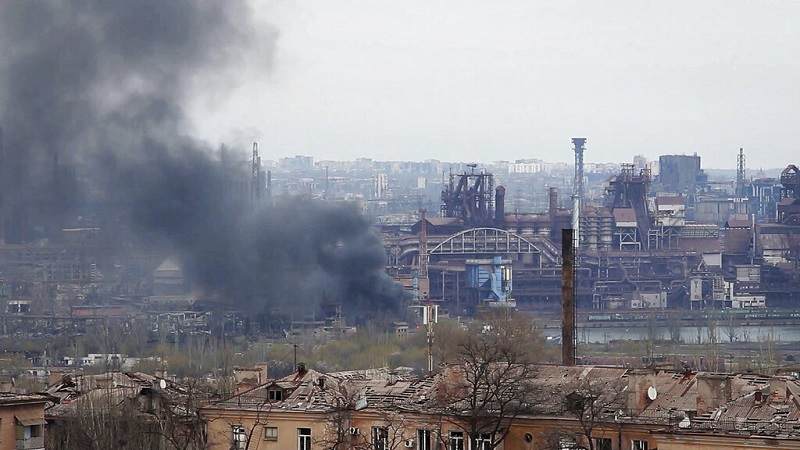
In this photo taken from video smoke rises from the Metallurgical Combine Azovstal in Mariupol, in territory under the government of the Donetsk People’s Republic, eastern Ukraine, Tuesday, May 3, 2022.
15:12 JST, May 4, 2022
Ukrainian officials and the United Nations held out hope for more evacuations from the bombed-out steel mill in Mariupol as scores of civilians reached relative safety after enduring weeks of Russian shelling against the city’s last pocket of resistance.
While the evacuees savored hot food, clean clothing and other comforts that were denied to them while underground, Russian forces on Tuesday began storming the plant, where some Ukrainian fighters were still holed up.
Thanks to the evacuation effort over the weekend, 101 people — including women, the elderly, and 17 children, the youngest 6 months old — emerged from the bunkers under the Azovstal steelworks to “see the daylight after two months,” said Osnat Lubrani, the U.N. humanitarian coordinator for Ukraine.
One evacuee said she went to sleep at the plant every night afraid she wouldn’t wake up.
“You can’t imagine how scary it is when you sit in the bomb shelter, in a damp and wet basement, and it is bouncing and shaking,” 54-year-old Elina Tsybulchenko said upon arriving in the Ukrainian-controlled city of Zaporizhzhia, about 140 miles (230 kilometers) northwest of Mariupol, in a convoy of buses and ambulances.
She said if the shelter were hit by a bomb like the ones that left the huge craters she saw on the two occasions she ventured outside, “all of us would be done.”
Evacuees, a few of whom were in tears, made their way from the buses into a tent offering food, diapers and connections to the outside world. Some of the evacuees browsed racks of donated clothing, including new underwear.
The news for those left behind was more grim. Ukrainian commanders said Russian forces backed by tanks began storming the sprawling plant, which includes a maze of tunnels and bunkers spread out over 11 square kilometers (4 square miles).
It was unclear how many Ukrainian fighters were still inside, but the Russians put the number at about 2,000 in recent weeks, and 500 were reported to be wounded. A few hundred civilians also remained there, Ukrainian Deputy Prime Minister Iryna Vereshchuk said.
“We’ll do everything that’s possible to repel the assault, but we’re calling for urgent measures to evacuate the civilians that remain inside the plant and to bring them out safely,” Sviatoslav Palamar, deputy commander of Ukraine’s Azov Regiment, said on the messaging app Telegram.
He added that throughout the night, the plant was hit with naval artillery fire and airstrikes. Two civilian women were killed and 10 civilians wounded, he said.
The U.N.’s Lubrani expressed hope for further evacuations but said none had been worked out.
In his nightly video address, Ukrainian President Volodymyr Zelenskyy said that by storming the steel mill, Russian forces violated agreements for safe evacuations. He said the prior evacuations are “not a victory yet, but it’s already a result. I believe there’s still a chance to save other people.”
In other battlefield developments, Russian troops shelled a chemical plant in the eastern city of Avdiivka, killing at least 10 people, Donetsk regional Gov. Pavlo Kyrylenko said.
“The Russians knew exactly where to aim — the workers just finished their shift and were waiting for a bus at a bus stop to take them home,” Kyrylenko wrote in a Telegram post. “Another cynical crime by Russians on our land.”
Just to the north, near the strategic junction city of Izyum, Russia has deployed 22 battalion tactical groups in its attempt to advance along the northern axis of the Donbas, the British Defense Ministry reported Wednesday. Each unit typically numbers about 700 soldiers.
Despite struggling to break through Ukrainian defenses and build momentum, Russia likely intends to proceed beyond Izyum to capture the cities of Kramatorsk and Severodonetsk, according to the British assessment, and encircle Ukrainian troops in the Kharkiv region. However, Moscow’s push has been slow as Ukrainian fighters dig in and use long-range weapons, like howitzers, to target the Russians.
The U.S. believes Ukrainians in recent days have pushed Russian forces about 40 kilometers (25 miles) east of Kharkiv, the country’s second-largest city. Extending the distance of the front line makes it more difficult for Russia to target the city with artillery fire. Ukrainian authorities said that during the last week their forces regained control of at least 11 villages around Kharkiv, most of them were occupied by the Russians for more than two months.
Ukraine’s eastern industrial heartland of Donbas remains Moscow’s stated objective after failing to take Kyiv in the early weeks of the war.
Explosions were also heard in Lviv, in western Ukraine, near the Polish border. The strikes damaged three power substations, knocking out electricity in parts of the city and disrupting the water supply, and wounded two people, the mayor said. Lviv has been a gateway for NATO-supplied weapons and a haven for those fleeing the fighting in the east.
Russian Defense Ministry spokesman Maj. Gen. Igor Konashenkov said Russian aircraft and artillery hit hundreds of targets in the past day, including troop strongholds, command posts, artillery positions, fuel and ammunition depots and radar equipment.
Ukrainian authorities said the Russians also attacked at least a half-dozen railroad stations around the country.
The assault on the Azovstal steelworks began almost two weeks after Russian President Vladimir Putin ordered his military not to storm the plant to finish off the defenders but to block it off. The first — and so far only — civilians to be evacuated from the shattered plant got out during a brief cease-fire in an operation overseen by the U.N. and the Red Cross.
At a reception center in Zaporizhzhia, stretchers and wheelchairs were lined up, and children’s shoes and toys awaited the convoy. Medical and psychological teams were on standby.
Some of the elderly evacuees appeared exhausted as they arrived. Some of the younger people, especially mothers comforting babies and other young children, appeared relieved.
“I’m very glad to be on Ukrainian soil,” said a woman who gave only her first name, Anna, and arrived with two children, ages 1 and 9. “We thought we wouldn’t get out of there, frankly speaking.”
A small group of women held up signs in English asking that fighters also be evacuated from the steel plant.
The arrival of the evacuees was a rare piece of good news in the nearly 10-week conflict that has killed thousands, forced millions to flee the country, laid waste to towns and cities, and shifted the post-Cold War balance of power in Eastern Europe.
In addition to the 101 people evacuated from the steelworks, 58 joined the convoy in a town on the outskirts of Mariupol, Lubrani said. About 30 people who left the plant decided to stay behind in Mariupol to try to find out whether their loved ones were alive, Lubrani said. A total of 127 evacuees arrived in Zaporizhzhia, she said.
The Russian military said earlier that some of the evacuees chose to stay in areas held by pro-Moscow separatists.
Tsybulchenko rejected Russian allegations that the Ukrainian fighters wouldn’t allow civilians to leave the plant. She said the Ukrainian military told civilians that they were free to go but would be risking their lives if they did so.
“We understood clearly that under these murder weapons, we wouldn’t survive, we wouldn’t manage to go anywhere,” she said.
Mariupol has come to symbolize the human misery inflicted by the war. The Russians’ two-month siege of the strategic southern port has trapped civilians with little or no food, water, medicine or heat, as Moscow’s forces pounded the city into rubble. The plant in particular has transfixed the outside world.
Mariupol’s fall would deprive Ukraine of a vital port, allow Russia to establish a land corridor to the Crimean Peninsula, which it seized from Ukraine in 2014, and free up troops for fighting elsewhere in the Donbas.
"News Services" POPULAR ARTICLE
-

American Playwright Jeremy O. Harris Arrested in Japan on Alleged Drug Smuggling
-

Japan’s Nikkei Stock Average as JGB Yields, Yen Rise on Rate-Hike Bets
-

Japan’s Nikkei Stock Average Licks Wounds after Selloff Sparked by BOJ Hike Bets (UPDATE 1)
-

Japan’s Nikkei Stock Average Buoyed by Stable Yen; SoftBank’s Slide Caps Gains (UPDATE 1)
-

Japanese Bond Yields Zoom, Stocks Slide as Rate Hike Looms
JN ACCESS RANKING
-

Keidanren Chairman Yoshinobu Tsutsui Visits Kashiwazaki-Kariwa Nuclear Power Plant; Inspects New Emergency Safety System
-

Tokyo Economic Security Forum to Hold Inaugural Meeting Amid Tense Global Environment
-

Imports of Rare Earths from China Facing Delays, May Be Caused by Deterioration of Japan-China Relations
-

University of Tokyo Professor Discusses Japanese Economic Security in Interview Ahead of Forum
-

Japan Pulls out of Vietnam Nuclear Project, Complicating Hanoi’s Power Plans
























